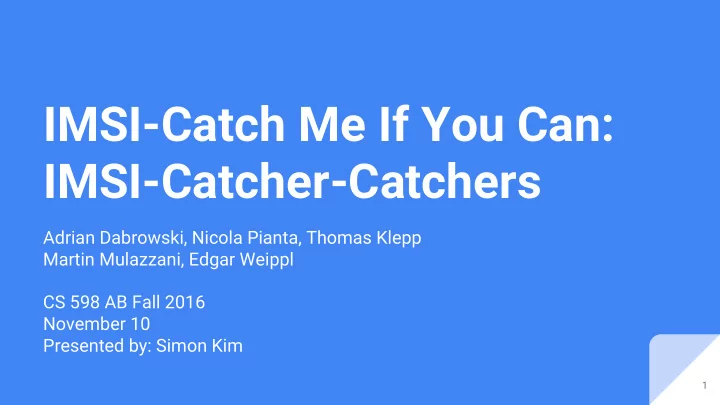

IMSI-Catch Me If You Can: IMSI-Catcher-Catchers Adrian Dabrowski, Nicola Pianta, Thomas Klepp Martin Mulazzani, Edgar Weippl CS 598 AB Fall 2016 November 10 Presented by: Simon Kim 1
IMSI Catcher 2
IMSI Catcher ● MITM fake base station ● Exploits GSM(2G)’s lack of mutual authentication Obtains device-network information from ● nearby phones ● Two modes: ○ Identification mode - retrieves information and sends the phone back to genuine network Camping mode - captures data and forwards them to ○ genuine network 3 https://www.hacking-lab.com/export/sites/www.hacking-lab.com/cases/4052-imsi-catcher/imsi.jpg
Cell Towers GSM cell identified by ● ○ MCC - country ○ MNC - network ○ LAC - location area ○ CI - cell id ● Neighbor list includes frequency and channel quality metrics 4 https://upload.wikimedia.org/wikipedia/en/5/57/CellTowersAtCorners.gif
Artifacts ● Unusual frequency ○ Unallocated channel (guard channel or reserved) ○ Advertised channel not in use ● Unusual cell ID Cell ID from another region ○ ● Changes in cell capabilities (e.g. GPRS or EDGE) ● Inconsistent network parameters (threshold, timeout values) 5
Artifacts (cont.) ● Channel noise resulting from RF jamming ○ To force location update/register ○ To force downgrading to GSM ● Absence of cipher Empty or inconsistent neighbor cell list ● Missing caller ID ● ● Short living cells 6
IMSI Catcher Catcher (ICC) 7
Features ● Simple, cheap, and easily deployable Collect and maintain its own cell ● ID database ● Detection based on the artifacts 8
Approaches ● Based on geo-network topology correlation ● Stationary (sICC) Constantly scans all frequency bands ○ ○ Larger coverage (can form a network) Good for detecting transient events ○ ○ Features Cell ID mapping ■ ■ Frequency usage ■ Cell lifetime, capabilities, network parameters ■ Jamming 9
Approaches (cont.) ● Mobile (mICC) ○ Smartphone application that uses standard Android API ■ No rooting or jailbreak required ○ Uses built-in GPS receiver ■ Geographical correlation ■ Cell ID 10
Difficulties ● Limited access to cell network information (e.g. neighbor list) ● Support varies by manufacturers Short neighbor list (very limited view) ● ○ Each station could focus on a specific band to extend the view ○ Foreign SIM may be able to use multiple networks 11
Difficulties (cont.) 12
Implementation - Stationary ● Telit GT864, Raspberry Pi, Internet connection Data collected locally in sqlite3 ● database ○ Periodically uploaded to central server Total cost = € 200 ● 13
Implementation - Mobile ● Measurements triggered by PhoneStateListener.onCellInfoChanged() or 10 second timer Detects redirection from/to another cell (IMSI catcher in identification mode) ○ ● Measured by 150x100 rectangular geographical tiles ● Data stored in local sqlite3 database Tile ready for evaluation, only if all 9 tiles have valid information ● Tile obtains information if detected as serving or included in one of the ● neighbor lists 14
Implementation - Mobile (cont.) 15
Evaluation ● Lab test - detecting an IMSI catcher in identification mode within a controlled environment Field test ● ○ Stationary - long-term data collection in Viennese city center ○ Mobile - data collection during an event in Vienna 16
Evaluation - Stationary ● Can sweep whole 900 and 1800 Mhz GSM and EGSM within 5-7 min ● Network parameters Cells within the same network have same values for most information. ○ ○ Values differ by each network operator Notable anomalies ● ○ Some cells operating outside of official range ○ Cells with valid MNC, LAC, CI but invalid NCC (network country code) 17
Cell ID lifetime throughout the experiment 18
Future Work ● New stationary ICC prototype Directly decoding the broadcast and control channels to gain more information for ○ fingerprinting ○ Could allow detecting some DoS attacks Further studies on occasional excessive range caused by weather ● 19
Future Work (cont.) ● Detecting DoS attacks Simulation shows that each network has ○ different individual paging retry policy ○ The presence of DoS attack clearly affects the distribution. 20
Summary ● Survey of network level artifacts caused by IMSI catchers ● Concept of usable, customer-grade warning system Available and implementable Detection methods by hardware ○ ○ Intentionally excluded expensive protocol analyzers or complex self-built solution 21
Discussion ● Is 4G LTE doing any better at defending against IMSI catcher? Is ICC still useful for 4G LTE? Is it necessary to restrict access to cell network information? Is there any ● incentive for manufacturers to make them more accessible through API? ○ For example, serving cell or neighbor list became popular because companies found use cases for those information (coarse locating devices in combination with a geolocation cell ID databases) ● How can we make the proposed mICC app better? ○ For example, it doesn’t provide large coverage like sICC 22
Recommend
More recommend